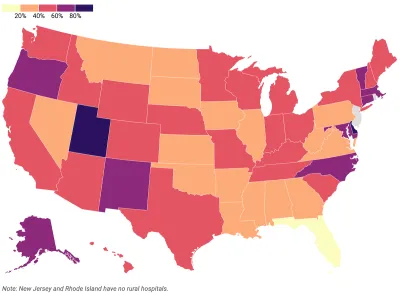In some states, as few as 9% of rural hospitals still deliver babies. As a result, rising pre-term births, no adequate pre-term care and "harrowing" close calls are a growing reality.

Rural hospitals across the United States are struggling to keep their labor and delivery departments open, putting safe birth care more than an hour away for many rural women.
As Anna Claire Vollers explains in the Maine Morning Star, over 100 hospitals in 26 states have closed their L&D departments since 2020, according to a report from the Center for Healthcare Quality & Payment Reform. Today, less than 1,000 rural hospitals offer labor and delivery services.
“Staffing shortages, low Medicaid reimbursement payments and declining birth rates have contributed to the closures. Some states have responded by changing how Medicaid funds are spent, by allowing the opening of freestanding birth centers, or by encouraging urban-based obstetricians to open satellite clinics in rural areas.” This leads to women giving birth in emergency rooms, a lack of adequate prenatal care, and an increase in preterm births.
Because L&D units must have staff on call 24/7, they are “expensive and complicated” to maintain. “In most cases, insurers don’t pay hospitals to maintain that standby capacity; they’re paid per birth. Hospitals cover their losses on obstetrics with revenue they get from more lucrative services.” For rural hospitals with low numbers of births, the cost is sometimes too much to cover.
Proposed cuts to Medicaid could make the situation worse, despite the Trump administration’s other efforts to promote higher birth rates.
FULL STORY: ‘Expensive and complicated’: Most rural hospitals no longer deliver babies

Planetizen Federal Action Tracker
A weekly monitor of how Trump’s orders and actions are impacting planners and planning in America.

Vehicle-related Deaths Drop 29% in Richmond, VA
The seventh year of the city's Vision Zero strategy also cut the number of people killed in alcohol-related crashes by half.

As Trump Phases Out FEMA, Is It Time to Flee the Floodplains?
With less federal funding available for disaster relief efforts, the need to relocate at-risk communities is more urgent than ever.

Berkeley Approves ‘Middle Housing’ Ordinance
The city that invented single-family zoning is finally reckoning with its history of exclusion.

SEPTA Budget Slashes Service by 45 Percent
The Philadelphia-area transit agency is legally tasked with maintaining a balanced budget. Officials hope the state will come to the rescue with additional funding.

Connecticut Governor Vetoes Housing Bill
Gov. Lamont reversed his view on a controversial affordable housing bill that would have required municipalities to zone for set amounts of affordable housing to receive state funding.
Urban Design for Planners 1: Software Tools
This six-course series explores essential urban design concepts using open source software and equips planners with the tools they need to participate fully in the urban design process.
Planning for Universal Design
Learn the tools for implementing Universal Design in planning regulations.
Heyer Gruel & Associates PA
JM Goldson LLC
Custer County Colorado
City of Camden Redevelopment Agency
City of Astoria
Transportation Research & Education Center (TREC) at Portland State University
Camden Redevelopment Agency
City of Claremont
Municipality of Princeton (NJ)





























